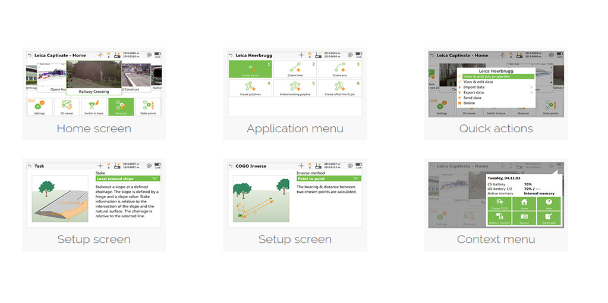This week, Alastair Green, Business Director of Field Measurement Software and Field Controllers at Leica Geosystems, discusses field software and in particular, the Leica Captivate software. The Captivate Experience is to a large extent owed to its sleek and cutting-edge user interface, designed by Ergosign and usable on a range of devices, including the Leica CS20 field controller and Leica CS35 tablet.
In June 2015, the Leica Captivate experience was launched. At the same time, the Leica CS20 field controller and Leica CS35 tablet were also released, both of which run using the Leica Captivate software. In your last blog interview, we discussed the field controller and the tablet – can you please tell us a bit about the Leica Captivate field software today? Perhaps you could start by explaining where the ideas for the design of the software came from…
Simply put, the ideas for the software come from a wide range of sources. For example, a lot of input comes from our existing customers using the previous generation field software – SmartWorx Viva – what they liked, what was not liked, what functionality was used most and what was not, how they saw the future of surveying software and so on. We also spent a lot of time looking at our competitor’s field software – what they do well, do they have ideas we can use?
However we did not only look at field software – the inspiration for Leica Captivate comes from maybe less expected sources. iPads, tablets, SmartPhones are of course incredibly popular. What makes them popular? What aspects of these softwares do people like using? What ideas could we also use in Leica Captivate? And of course everyday life also provides ideas. For instance, car navigation systems allow drivers to navigate to their destination with the display showing the surrounding roads moving by as the car moves along. And this is not that much different to an engineer staking a point – so why not also show the surrounding points, CAD data, scanned data and all other data move by as the engineer navigates to the design point…
With all this input for ideas, how do you then decide what to include in the software and what not to?
It was Steve Jobs who once said something like “People think focus means saying yes to the thing you’ve got to focus on. But that’s not what it means at all. It means saying no to the hundred other good ideas that are there. You have to pick carefully”. This was incredibly relevant and true for us with the Leica Captivate software.
So what did this mean for you and your team? What did you say yes to? What did you carefully pick?
We eventually focussed on three key areas. The first was the user interface, or better expressed the user experience. The second was the graphical visualisation of data and the third was something we called “improving the basics”.
Can you tell us some more about each focus area?
Of course. I mentioned the user experience quite some in the previous Blog on field controllers, and it is basically the same. Many of our users have to use our software (and hardware) eight hours or more every day – on top of this, they often work in difficult, dirty or unpleasant conditions. If any part of our software or hardware usage is unpleasant, irritating or annoying, this would turn the entire user experience into a negative experience. With Leica Captivate, we wanted to make the user’s overall working day a little bit more pleasurable or enjoyable – a positive experience. There are many aspects of the software which add up to its positive experience – the look and feel of the software, the icon design, the transitions used when moving between the software, animations and so on. Many people seeing the software for the first time simply say “wow” – and this is exactly the positive user experience we wanted to create.
And what about the second focus area, the visualisation of data?
When designing this part of the software we often used the expression “3D everything, 3D every-where”. “3D”obviously means that the data can be viewed in 3D, “everything” means all data used within Leica Captivate is viewed in 3D – points, lines, scans, road, rail and tunnel alignments, CAD data and so on, and “everywhere” means this 3D visualisation is possible throughout the software – in all apps and wherever it is needed.
The third focus area, “improving the basics” means to make the tasks that a user repeatedly performs all day, every day, as simple and as easy as possible. For example, coding and linework is something many users do all day – this has been completely redesigned. Staking of points, lines, roads, rail and tunnels offers more graphical ways of working and so on.
So overall, are you and your team happy with the result, with the Leica Captivate software?
We are only happy if our users are happy and so far the feedback has been very positive – so yes, we are happy with the result. But of course this is not the end of the development of Leica Captivate – we will continue to listen to our users – extending and improving the software – this is really only the beginning.

Leica CS35 Controller with clean displays from Ergosign















